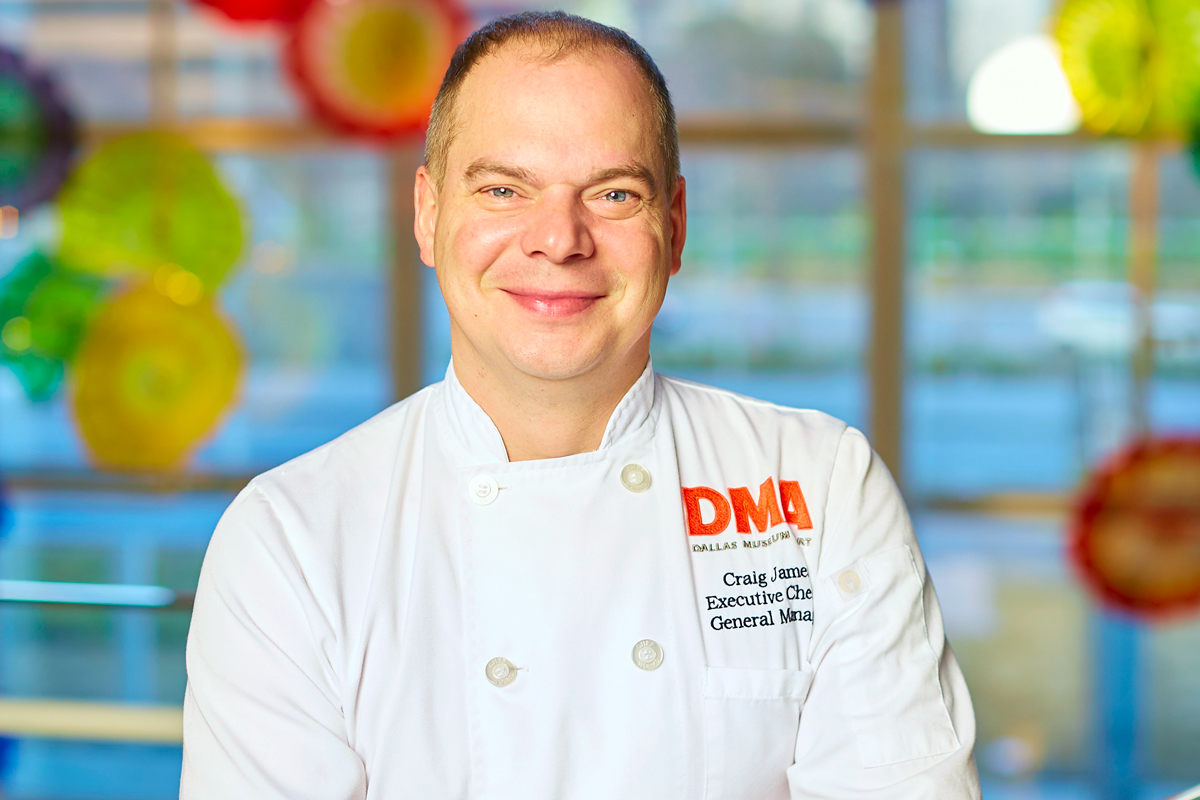In the March issue of the magazine, I wrote a piece about Craig James, chef and general manager of all things culinary at the Dallas Museum of Art. I’ve admired his work for years. A bowl of the DMA Café’s carrot-ginger soup with a wisp of cardamom foam is a weekly pleasure, and I’ve marveled at some of the things I’ve eaten at Arts & Letters Live events, even asking, once, for his recipe for rich, dark, and completely delicious date sticky toffee pudding—a recipe he gladly handed over after stepping into his office for a second to print it out. I only had 200 words in the magazine. Here are more details from my conversation with a Brit who’s cooked here, there, and everywhere and makes things like rook pie (think of the nursery rhyme “Sing a Song of Sixpence,” with its four-and-twenty blackbirds baked in a pie)—and smiles about it.
James worked for a number of years at country-house hotels in England, “the kind of hotel where you get up in the morning and go into the garden and see what’s growing.” As executive chef at the vast Quaglino’s in London, he oversaw a 36-chef brigade and served 500-1,000 for an average dinner service. “There was a smoking ban [in London], but there were cigarette girls [at Quaglino’s] with little skirts. And people would steal the ashtrays; we’d go through something like 10,000 ashtrays a year.” (You have to picture a grand venue, with a big, sweeping staircase and private dining room, pastry kitchen, crustacean station.)
He then opened his own restaurant in London, a 70-seat spot where “I was really focused on the product,” he says. If it was a question of meat, he knew about the animals’ feed, if dry-aged, how long it had hung—his approach “from the ground up” with a commitment to sourcing from within a small radius.
“I got a reputation for cooking esoteric things like squirrels, rooks, using flowers …” he says. Rook (blackbird, essentially) tastes “like a really tender squab.”
The cooking of squirrel was part of a conservation project, the idea being to trap grey squirrels, which have all but displaced the British red squirrel, and to use them nose-to-tail, making gloves from the pelt, fishing flies from the tails. James cooked saddle of squirrel and a pie of the liver and heart. He’s a huge fan of the whole-animal, nose-to-tail cooking that fellow Brit Fergus Henderson made famous at his London restaurant St. John. (Anthony Bourdain is also a tremendous fan.)
He ended up in Dallas via a circuitous route that involved impressing someone while at a cooking event with Hyatt hotels in Argentina and then finding himself here to cook Argentinian asado. It was 2008, and he was opening his own restaurant in London, but in Dallas he met the woman who would later become his wife (she is involved with events at the Nasher Sculpture Center, across the way, coincidentally), and by 2011 he was over on a fiancé visa. The gig at the DMA was a way to practice the art of cooking in a museum of fine art—and with a family, James didn’t want the grueling pace of restaurant hours.
His mission when he took the reins at the DMA, he says, was “everything as fresh as possible and in-house.” At the time, the culinary side of the DMA was in a transition period. “They were doing filled Tostitos as canapés,” he says. “They had [kitchen] equipment they didn’t know how to use. ‘Okay, this has to end,’” he said.
All the while, he’s catering to a broad and at times exacting audience: Arts & Letters Live events, exhibition openings, Director’s dinners, dinners for external clients such as AT&T or the local chapter of the Confrerie des Chevaliers du Tastevin, ambassadors of Burgundy wine.
“I’ve always enjoyed the history and science of food,” James says. Which is why he’s always been interested in bringing back old recipes involving cooking rooks and squirrels, and why something like the science of the meringue, that miracle of egg white, isn’t lost on him. “What was Escoffier thinking?” he says and smiles. He’s culminated tasting menus—the four-course French-themed dinner for the Confrerie, for example—with Floating Islands, puffy clouds of meringue floating elegantly in custard.
“I like to take people somewhere,” he says. “I really enjoyed the Keir collection,” for example, which allowed him to create menus with lamb shoulder and sticky toffee pudding.
And he enjoys the challenge of creating delightful things with non-extravagant means. So for a Keir collection opening, he served a take on a chicken kabob with harissa and couscous, but rather than sliding chicken onto a skewer and grilling, he turned the nibble into something elegant, making of the meat a mousseline and stuffing and poaching, so the end result was a chicken mousseline bite—nothing terribly fancy, but something, as he puts it, you can’t do at home.
For the Café, he keeps in mind the museum’s embrace of hordes of children, but even his fruit kabobs and ants on a log with house-ground almond butter aren’t ordinary children’s menu items.
“I miss the buzz of the service rush, when the ticket machine is spitting out tickets that are hitting the floor,” he says of his work now as opposed to his heady restaurant days.
The biggest challenge is the size of the space he gets. “The kitchen is tiny,” he says. And all electric, even the grill. Luckily, he disposes of an oven in which each shelf or rack can be adjusted individually. So sticky toffee puddings can be set at 350°F while something else is cooking at 500°F.
But perhaps my favorite comment, better than the stories of squirrel saddles and rook pies, is this one, on which he ended: “It must be something about the moisture or humidity settings for the art,” he said, contemplatively, “But spun-sugar work is almost impossible.”





